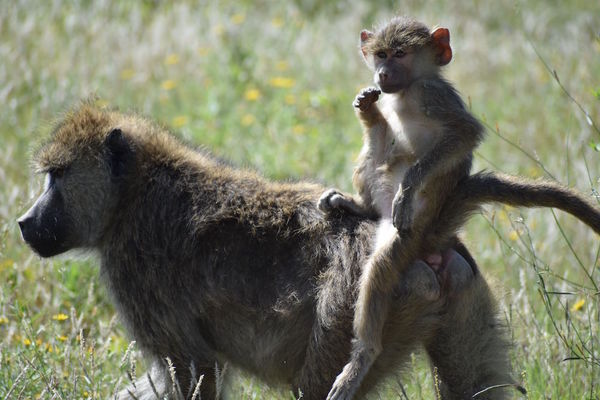
Around the world, girls who experience harsh conditions sometimes reach puberty at unusually young ages. One explanation for this accelerated puberty is that, because early life trauma can shorten lifespans, evolution may have shaped women’s development, leading them to “live fast” in anticipation of an early death.
However, a new study from the University of Notre Dame, which focused on baboons, has found no evidence that accelerated reproduction is an evolutionarily beneficial response to early life adversity. Instead, researchers found that individuals who start reproducing earlier, or who reproduce faster, are able to produce more offspring throughout their life. However, this benefit is not specific for individuals who experience early life adversity, meaning it is not a specific adaptation to such conditions.
As part of the Amboseli Baboon Research Project, scientists studied wild female baboons in Kenya over a period of several decades. They collected information on their early life environments, timing of maturation, and rate of reproduction. With this information, they were able to determine whether female baboons who experienced accelerated reproduction and early life adversity had higher lifetime reproductive success, or produced more offspring.
“Accelerated reproduction was thought to be an adaptive response that benefited those who had faced some early life trauma - a biological way of adapting to a potentially shorter lifespan,” said Chelsea Weibel, graduate student in the Department of Biological Sciences and lead author on the study. “Although we found accelerated reproduction can lead to fitness benefits, it is not a specific response to adversity experienced earlier in life.”
 Professor Elizabeth Archie
Professor Elizabeth ArchieThe study, published in the Proceedings of the National Academy of Sciences, compared and tracked which female baboons had experienced the death of a mother, when they first gave birth, the number of days between births, and more. They found no evidence that female baboons with short lifespans benefited from accelerated reproduction. In fact, the study showed that females who experienced maternal death – one type of early life adversity – may have experienced fitness costs as a result of accelerated reproduction.
Overall, the strongest predictor of higher lifetime reproductive success was long lifespans.
“The hypothesis that women facing early life adversity gain fitness benefits from early menstruation isn’t supported by our findings,” said Elizabeth Archie, associate professor in the Department of Biological Sciences at Notre Dame, affiliated member of Notre Dame’s Environmental Change Initiative and Eck Institute for Global Health, and co-author of the study. “While there is potential that this is a completely unique human trait, by studying baboons, we are able to conclude that the phenomenon likely does not have deep evolutionary roots.”
Archie and her team study baboons because, as long-lived mammals like humans, the researchers can record accurate, longitudinal data on a number of topics such as exactly what occurred in a baboon’s early life, when the baboon hits puberty, when the baboon reproduces and how often, and when the baboon dies. Baboons share a genetic similarity of 94 percent to humans, and the Amboseli Baboon Research Project, which is a more than 50-year collaborative project led by scientists at Duke, Notre Dame, and Princeton University, allows for continued research throughout the course of a lifetime. To conduct a similar study in humans would be less cost-effective and require research subjects to rely on memories of their early life, which could be less reliable.
As for next steps, the researchers aim to assess what trade-offs may occur due to early life adversity, as well as how early life adversity affects aging.
Other co-authors include Jenny Tung and Susan C. Alberts at Duke University. The study is supported by the National Institutes of Health and the National Science Foundation.
For more on the Amboseli Baboon Research Project, please visit amboselibaboons.nd.edu.
Contact:
Brandi Wampler / Research Communications Specialist
Notre Dame Research / University of Notre Dame
brandiwampler@nd.edu / +1.574.631.8183
research.nd.edu / @UNDResearch
About Notre Dame Research:
The University of Notre Dame is a private research and teaching university inspired by its Catholic mission. Located in South Bend, Indiana, its researchers are advancing human understanding through research, scholarship, education, and creative endeavor in order to be a repository for knowledge and a powerful means for doing good in the world. For more information, please see research.nd.edu or @UNDResearch.
Originally published by at research.nd.edu on September 22, 2020.